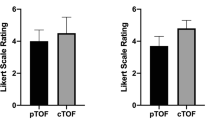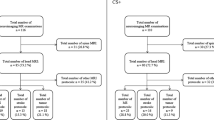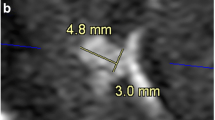Abstract
Objectives
To assess the image quality of sparsely sampled contrast-enhanced MR angiography (sparse CE-MRA) providing high spatial resolution and whole-head coverage.
Materials and methods
Twenty-three patients scheduled for contrast-enhanced MR imaging of the head, (N = 19 with intracranial pathologies, N = 9 with vascular diseases), were included. Sparse CE-MRA at 3 Tesla was conducted using a single dose of contrast agent. Two neuroradiologists independently evaluated the data regarding vascular visibility and diagnostic value of overall 24 parameters and vascular segments on a 5-point ordinary scale (5 = very good, 1 = insufficient vascular visibility). Contrast bolus timing and the resulting arterio-venous overlap was also evaluated. Where available (N = 9), sparse CE-MRA was compared to intracranial Time-of-Flight MRA.
Results
The overall rating across all patients for sparse CE-MRA was 3.50 ± 1.07. Direct influence of the contrast bolus timing on the resulting image quality was observed. Overall mean vascular visibility and image quality across different features was rated good to intermediate (3.56 ± 0.95). The average performance of intracranial Time-of-Flight was rated 3.84 ± 0.87 across all patients and 3.54 ± 0.62 across all features.
Conclusion
Sparse CE-MRA provides high-quality 3D MRA with high spatial resolution and whole-head coverage within short acquisition time. Accurate contrast bolus timing is mandatory.
Key points
• Sparse CE-MRA enables fast vascular imaging with full brain coverage.
• Volumes with sub-millimetre resolution can be acquired within 10 seconds.
• Reader’s ratings are good to intermediate and dependent on contrast bolus timing.
• The method provides an excellent overview and allows screening for vascular pathologies.




Similar content being viewed by others
Abbreviations
- MRA:
-
Magnetic Resonance Angiography
- AVM:
-
Arteriovenous malformation
- ToF:
-
Time of Flight
- PC:
-
Phase contrast
- RF:
-
Radiofrequency
- CE-MRA:
-
Contrast-enhanced magnetic resonance angiography
- SNR:
-
Signal to noise
- CNR:
-
Contrast to noise
- GRAPPA:
-
Generalized autocalibrating partially parallel acquisition
- SENSE:
-
Sensitivity encoding
- IQ:
-
Image quality
- FoV:
-
Field of view
- FISTA:
-
Fast iterative shrinkage/thresholding algorithm
References
Scarabino T, Carriero A, Magarelli N et al (1998) MR angiography in carotid stenosis: a comparison of three techniques. Eur J Radiol 28:117–125
Modaresi KB, Cox TCS, Summers PE et al (1999) Comparison of intraarterial digital subtraction angiography, magnetic resonance angiography and duplex ultrasonography measuring carotid artery stenosis. Br J Surg 86:1422–1426
Mine B, Pezzullo M, Roque G et al (2015) Detection and characterization of unruptured intracranial aneurysms: comparison of 3T MRA and DSA. J Neuroradiol 42:162–168
Dumoulin CL, Cline HE, Souza SP et al (1989) Threedimensional time-of-flight magnetic resonance angiography using spin saturation. Magn Reson Med 11:35–46
Bryant D, Payne J, Firmin D et al (1984) Measurement of flow with NMR imaging using a gradient pulse and phase difference technique. J Comput Assist Tomogr 8:588–593
Nederkoorn PJ, van der Graaf Y, Eikelboom BC et al (2002) Time-of-Flight MR angiography of carotid stenosis: does a flow void represent severe stenosis. AJNR 23:1779–1784
Ozsarlak O, Van Goethem JW, Maes M et al (2004) MR angiography of the intracranial vessels: technical aspects and clinical applications. Neuroradiology 46:955–972
Unlu E, Temizoz O, Albayram S et al (2006) Contrast-enhanced MR 3D angiography in the assessment of brain AVMs. Eur J Radiol 60:367–378
Cirillo M, Scomazzoni F, Cirillo L et al (2013) Comparison of 3D TOF-MRA and 3D CE-MRA at 3T for imaging of intracranial aneurysms. Eur J Radiol 82:e853–e859
Maki JH, Prince MR, Londy FJ et al (1996) The effects of time varying intravascular signal intensity and k-space acquisition order on three-dimensional MR angiography image quality. J Magn Reson Imaging 6:642–651
Cao Y, Levin DN, Yao L (1996) Locally focused MRI: applications to dynamic and spectroscopic imaging. Magn Reson Med 36:834–846
Kuperman VY, Nagle SK, Alley MT et al (1999) Locally focused contrast-enhanced carotid MRA. J Magn Reson Imaging 9:663–669
Griswold MA, Jakob PM, Heidemann RM et al (2002) Generalized autocalibrating partially parallel acquisitions (GRAPPA). Magn Reson Med 47:1202–1210
Lustig M, Donoho D, Pauly JM (2007) Sparse MRI: the application of compressed sensing for rapid MR imaging. Magn Reson Med 58:1182–1195
Grist TM, Mistretta CA, Strother CM, Turski PA (2012) Time-resolved angiography: past, present, and future. J Magn Reson Imaging 36:1273–1278
Stalder AF, Schmidt M, Quick HH et al (2014) Highly undersampled contrast-enhanced MRA with iterative reconstruction: Integration in a clinical setting. Magn Reson Med. doi:10.1002/mrm.25565
Spearman C (1904) The proof and measurement of association between two things. Am J Psychol 15:72–101
Villablanca JP, Nael K, Habibi R et al (2006) 3 T contrast-enhanced magnetic resonance angiography for evaluation of the intracranial arteries: comparison with time-of-flight magnetic resonance angiography and multislice computed tomography angiography. Investig Radiol 41:799–805
Butz B, Dorenbeck U, Borisch I et al (2004) High-resolution contrast-enhanced magnetic resonance angiography of the carotid arteries using fluoroscopic monitoring of contrast arrival: diagnostic accuracy and interobserver variability. Acta Radiol 45:164–170
Vogt FM, Theysohn JM, Michna D et al (2013) Contrast-enhanced time-resolved 4D MRA of congenital heart and vessel anomalies: image quality and diagnostic value compared with 3D MRA. Eur Radiol 23:2392–2404
Krasny A, Nensa F, Sandalcioglu IE et al (2014) Association of aneurysms and variation of the A1 segment. J Neurointerv Surg 6:178–183
Acknowledgments
The scientific guarantor of this publication is Harald H. Quick. The authors of this manuscript declare relationships with the following companies: This work was supported by a research agreement between Siemens Healthcare GmbH, Erlangen, Germany, and the University Hospital Essen, Essen. The works-in-progress (WIP) prototype sparse MRA sequence was provided by Siemens Healthcare GmbH, Erlangen, Germany. The authors are grateful for the support and helpful discussions to Michaela Schmidt and Dr. Aurelien Stalder, both Siemens Healthcare, Erlangen. One of the authors has significant statistical expertise. Institutional Review Board approval was obtained. Written informed consent was obtained from all subjects (patients) in this study. Methodology: retrospective, observational / experimental, performed at one institution.
Author information
Authors and Affiliations
Corresponding author
Rights and permissions
About this article
Cite this article
Gratz, M., Schlamann, M., Goericke, S. et al. Evaluation of fast highly undersampled contrast-enhanced MR angiography (sparse CE-MRA) in intracranial applications – initial study. Eur Radiol 27, 1004–1011 (2017). https://doi.org/10.1007/s00330-016-4398-z
Received:
Revised:
Accepted:
Published:
Issue Date:
DOI: https://doi.org/10.1007/s00330-016-4398-z




